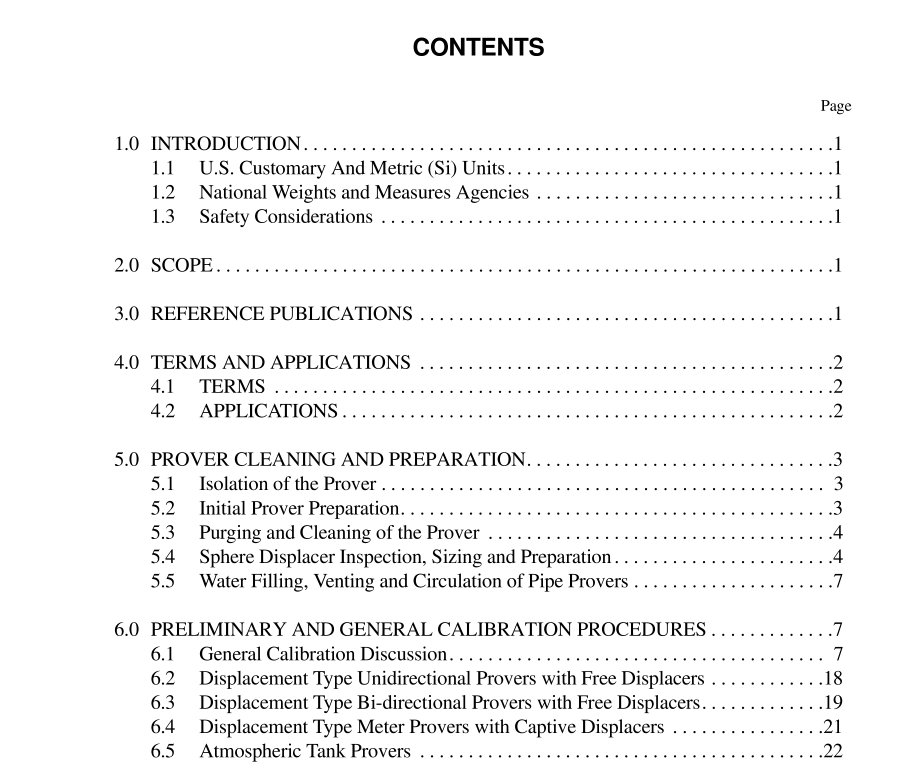API MPMS 4.9.2 pdf download

API MPMS 4.9.2 pdf download.Manual of Petroleum Measurement Standards Chapter 4—Proving Systems
5.0 Prover Cleaning And Preparation
5.1 ISOLATION OF THE PROVER
The prover and its auxiliary piping shall be isolated from all operating systems by either physical isolation with blinds, blind flanges, blanks, spectacles or double block and bleed valves to separate it from the upstream and downstream operating line pres- sures and products. A complete visual inspection should be made of the entire prover system to assure that the system is properly isolated.
5.2 INITIAL PROVER PREPARATION
New or repaired provers are generally hydrostatically tested prior to placing into service. When a hydrostatic test is required, it shall be conducted prior to the waterdraw calibration. This ensures that the calibrated volume will not be altered by permanent pipe expansion, subsequent tightening of flanges, etc. Piston provers shall be waterdrawn using the same piston design and seals, both material and style, that are utilized in the prover’s normal meter proving operation. Substitution of spheres for the piston dur- ing calibration shall not be allowed. Connections to pipe work or flexible hoses are required for water circulation through the prover. These are typically 2 in. threaded connections, which should be as close to the calibrated section as practical. (If vents and drains are being considered for water- draw connections, their location should ensure that all the water used in the calibration will be circulated through the entire prov- ing system. This is necessary to maintain constant temperature in the calibration water.) Adequate water flow is required to launch the displacer in a pipe prover. High point vent valves should be inspected. If damaged, defective or leaking they should be repaired or replaced prior to the cali- bration. Vent valves, in good working order, are necessary for all prover calibrations, to ensure that all air or vapor has been vented from the prover prior to the start of each calibration pass. Before a prover calibration, all relief valves should be removed, checked for leakage, repaired and re-calibrated as necessary. If in place during the prover calibration then the relief valves should be isolated. If not isolated they must be disconnected from the drain system and regular visual checks for any leakage shall be made.Drain valves, either on the prover itself, or in manifolds and pipe-work connected to the prover but not isolated from it, must all be inspected for leakage and either sealed off or left uncoupled to enable a visual determination of any leakage during the calibra- tion runs. Calibration of a prover with the sphere launching interchange or four-way valve isolated does not verify the integrity of operation of the complete proving system. Rather, it simply calibrates the volume contained in a pipe between two switches, which may or may not be acceptable to all the parties concerned. Depending upon the type of prover to be calibrated the following operations should be performed: • On a bi-directional prover if its four-way valve is to be used in the calibration process, it shall be checked for condition, smoothness of operation, verify that the seals are holding and ascertain that the valve is leak free. A final check should be made after the prover has been cleaned. • On a unidirectional prover, if its interchange is to be used in the calibration process, it shall be verified that it is operating correctly, sealing fully, and is leak free. A final check should be made after the prover has been cleaned. • On provers with captive displacers, a seal leak verification test should be performed. Replace any seals as necessary. Make sure all waterdraw programs and or control boards are present, installed, and working correctly. Any valves or valve sys- tems located internally in the piston, in the prover body itself or in any of the associated pipe-work should be verified and tested. Consult the manufacturer’s recommendations for all specifications, leak testing procedures and calibration proce- dures.









